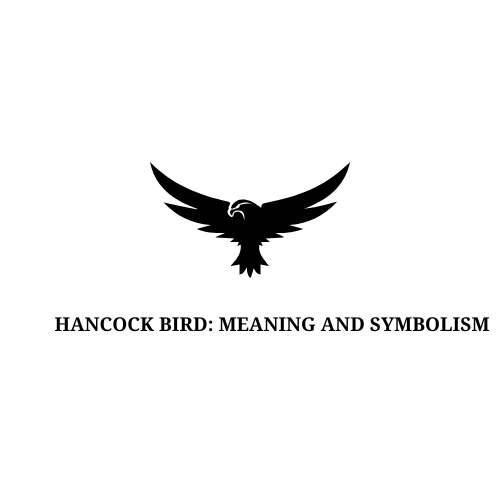Hancock Bird: Meaning and Symbolism
The Hancock bird is a fascinating symbol with roots in both different cultures, it holds deep significance, and its meaning has evolved over time.
To understand the Hancock symbolism, I began a journey to uncover the reasons behind its widespread fascination and importance.
This exploration isn’t about a specific species of bird, but rather about the symbolic meanings attached to it throughout history. The Hancock carries rich layers of meaning that go beyond its physical form, reflecting beliefs, values, and cultural connections that have transcended across time and geography.
Over the years, the symbolism of the Hancock bird has shifted, yet it continues to represent universal themes such as freedom, transformation, and connection to the divine.
By understanding its symbolic value, we can gain insights into how humans relate to nature and the deeper meanings we attach to the world around us.
Ultimately, the Hancock serves as a powerful reminder that meanings are not fixed—they change with culture, time, and individual perception, offering us a timeless symbol to reflect upon.

Exploring the Symbolic and Cultural Significance of the Hancock Bird
Introduction to the Hancock Bird’s Cultural Impact
Originating from ancient myths and folklore, the Hancockweaves through the fabric of many cultures, enriching its narrative with each tale. This mythical creature represents a spectrum of meanings across different societies.
In some, it is a symbol of wisdom and knowledge; in others, it stands for transformation and renewal. As perceptions vary, the Hancock transitions from a protective spirit to an emblem of change.
Read more: Introduction to the Hancock Bird’s Cultural Impact
deeply influencing cultural rituals, traditions, and foundational stories, thereby integrating itself into both human history and the natural world.
Symbolic Interpretations Across Literature and Art
In the realms of literature and art, the bird emerges as a profound symbol. Its flight, vibrant feathers, and distinct call encapsulate human emotions, portraying themes of freedom, permanence, and the transient nature of life.
The bird’s representation varies widely across cultures—it may guide spiritual journeys, embody love and loyalty, or herald good fortune.
Also reed: Hummingbird-feeder-maintenance-in-winterAs times change, so does the bird’s symbolic meaning, mirroring contemporary concerns and aspirations, and highlighting our ongoing quest for meaning and connection in a dynamic world.
The Hancock Bird’s Role in Natural History
In ecological terms, the Hancock bird occupies a unique niche. Adapting to diverse environments like dense forests and expansive fields, it thrives in various climates.
Its striking plumage and distinctive calls not only aid in survival and mating but also make it a subject of interest among nature enthusiasts.
The bird’s behaviors—ranging from migration patterns to feeding habits—offer insights into its ecological role and contribute to our understanding of biodiversity.

Custom Hancock Bird Patches: A Trending Accessory
For those enchanted by the Hancock, custom patches offer a creative way to express admiration. These patches, which can adorn clothing, hats, and bags, come in various colors and designs, celebrating the freedom and beauty the bird symbolizes.
Whether as a fashion statement or a personal emblem, these patches allow individuals to carry a piece of the Hancock enduring legacy with them.
Also reed: meaning-and-symbolism-of-the-hancock-birdConservation Status and Environmental Significance of the Hancock Bird
The Hancock bird is increasingly recognized for its symbolic connection to environmental conservation. Its conservation status is a growing concern due to several threats, including habitat loss and climate change. As a result, the bird has become a symbol of the collective responsibility to protect our natural world.
Efforts to conserve the bird are focused on preserving its habitat, supporting breeding programs, and raising public awareness.
These initiatives highlight the urgent need for balance between human activity and wildlife protection. The bird represents not only a specific species but also the broader need for ecological balance and sustainable coexistence with nature.
Protecting this bird is a reminder that human actions must be aligned with the preservation of biodiversity and natural resources.

The Hancock Bird in Popular Culture and Design:
Beyond its ecological importance, the Hancock has made a significant impact on popular culture. Its mystique and symbolic power have captured the imagination of creators in various forms of media, including films, literature, and art. T
he bird is often depicted as a symbol of freedom, transformation, and mystical beauty, resonating with audiences across different cultures and generations.
In the world of fashion and design, the Hancock vivid imagery has inspired trends in both high fashion and everyday wear. Its vibrant colors and graceful form have influenced designers in clothing, accessories, and even interior design.
The bird’s symbolism of beauty and freedom continues to inspire a wide range of creative expressions.
Incorporating Hancock Bird Symbolism into Personal Style
For those drawn to the cultural and symbolic meaning of the Hancock bird, custom pendants and accessories offer a way to showcase this connection.
Using Hancock bird patterns, colors, and symbols, individuals can design unique, personalized jewelry that reflects their respect for the bird’s cultural significance.
Whether in fashion or art, incorporating the Hancock bird’s symbolism into your daily life allows for a personal expression of individuality and an appreciation for the bird’s deeper meaning.
FAQ’s:
1. What is the symbolic meaning of the Hancock bird?
Answer: The Hancock bird is often viewed as a symbol of freedom, transformation, and spiritual guidance. In different cultures, it represents wisdom, renewal, and connection to the divine.
Its flight and vibrant feathers are also associated with beauty and grace. Across history, the bird has symbolized the cyclical nature of life and the pursuit of higher knowledge.
2. How does the Hancock bird relate to conservation efforts?
Answer: The Hancock bird plays a crucial role in raising awareness about environmental conservation. Its conservation status is a concern due to threats like habitat loss and climate change.
As a symbol of ecological balance, it highlights the need to protect wildlife and preserve natural habitats. Conservation efforts focus on habitat preservation, breeding programs, and educating the public about the importance of protecting biodiversity.
3. What cultural significance does the Hancock bird have?
Answer: The Hancock bird has deep roots in mythology and folklore across various cultures. It often symbolizes spiritual journeys, wisdom, and renewal.
In many cultures, it is seen as a messenger or a guide, helping individuals navigate life’s challenges. Its symbolic meaning varies but generally conveys themes of hope, protection, and personal transformation.
4. How is the Hancock bird represented in art and literature?
Answer: In art and literature, the Hancock bird is commonly used as a symbol of freedom and life’s transience. It has inspired poets, writers, and artists, who use the bird to explore themes of impermanence and change.
The bird’s majestic flight and mystical allure often evoke emotions of longing and reflection, representing the journey of the soul or the search for meaning in life.
5. What are some modern ways the Hancock bird’s symbolism is expressed?
Answer: Today, the Hancock bird continues to inspire fashion, design, and pop culture. It appears in various creative expressions, from clothing and accessories to tattoos and home decor.
The bird’s symbolic imagery of beauty, freedom, and connection resonates with people, prompting the creation of custom items like pendants and patches that reflect its cultural and personal significance.
Conclusion:
In summary, the Hancock bird serves as both a cultural icon and a call to action for conservation. It continues to inspire through its presence in popular culture, fashion, and art, while reminding us of the importance of protecting the natural world.

